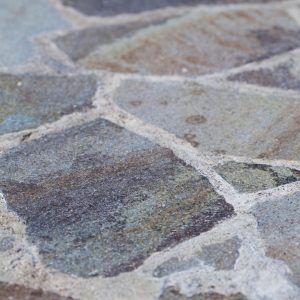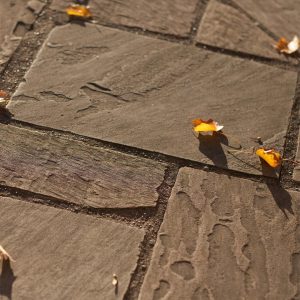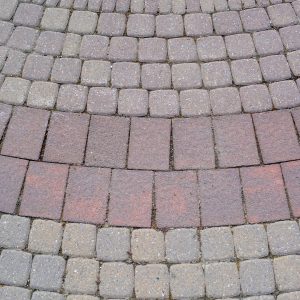The big advantage to natural stone is in the name. It’s natural. This means it’s built to weather the environment. Some types of natural stone will need treatment, and some are better outdoor stone flooring options than others. Outdoor natural stone flooring is a great way to make a patio or other outdoor feature that lasts a long time and feels good underfoot. Let’s walk through the strengths and weaknesses of a few types:
4 Outdoor Stone Flooring Options
1. Flagstone
 Flagstone works well for patios, entry ways, and paths through outdoor gardens. Flagstone outdoor flooring comes in a wide range of colors. They can include limestone, quartzite, and sandstones, among others. What’s common among all types of flagstone is that they come in irregular shapes that lend an area a hint of wilderness and unpredictability. It can be fun to arrange the shapes until you have the exact look you want.
Flagstone works well for patios, entry ways, and paths through outdoor gardens. Flagstone outdoor flooring comes in a wide range of colors. They can include limestone, quartzite, and sandstones, among others. What’s common among all types of flagstone is that they come in irregular shapes that lend an area a hint of wilderness and unpredictability. It can be fun to arrange the shapes until you have the exact look you want.
Flagstones generally have roughened surfaces, which helps a lot to maintain traction even when they’re wet after a rain.
Flagstone is installed on a bed of soil or sand. To hold up, you want stones at least an inch-and-a-half thick. Thinner slabs can be used by laying them in concrete or mortar, which can be advantageous if being installed around a feature such as a pool.
All types of natural stone should be sealed, but this is especially true for more porous stones like limestone.
2. Cut Stone
 Cut stone offers a more refined and orderly look. It’s good for outdoor areas because of its durability and uniformity. Unlike the irregular shapes of flagstone, cut stone comes in square or rectangular tiles.
Cut stone offers a more refined and orderly look. It’s good for outdoor areas because of its durability and uniformity. Unlike the irregular shapes of flagstone, cut stone comes in square or rectangular tiles.
Cut stone includes granite, marble, slate, and travertine, among others. The big advantage here is just how formal they look. The beauty of these stones combined with their straight lines can make a place feel orderly and calm.
These outdoor stone flooring options are generally smoother, so can be more slippery when wet. This is one reason why they’re sometimes installed spaced apart with looser stones or ground cover separating them.
3. Loose Materials
What’s meant by looser stones? This can include crushed stone, pea gravel, aggregate, decomposed granite, or sand. These options have gained a lot of popularity because they feel informal. That can create a unique contrast when placed beside areas of cut stone, or used to space cut stone apart.
4. Mixed Stone
 Mixed stone can mean using loose materials, cut stone, flagstone, brick, concrete, pavers or any mixture of these to create a unique look. Obviously, there’s a danger of making this look haphazard, so you want planning and a skilled eye for professional design when combining different outdoor stone flooring options.
Mixed stone can mean using loose materials, cut stone, flagstone, brick, concrete, pavers or any mixture of these to create a unique look. Obviously, there’s a danger of making this look haphazard, so you want planning and a skilled eye for professional design when combining different outdoor stone flooring options.
For instance: a flagstone patio leading up to a loose stone area with benches and a marble wall feature, with a garden separated by large, unique stones can look beautiful when well designed. Outdoor natural stone flooring can be used however you like. Pursue the looks you want and ask questions about how each stone flooring option can be used best. The team at East Coast Flooring & Interiors is here to help.